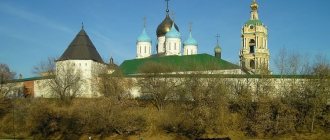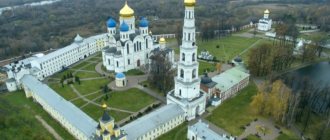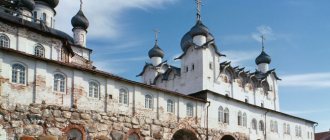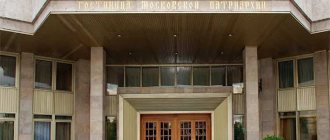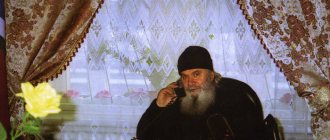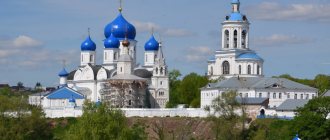There is a museum in the Holy Trinity Ipatiev Monastery
- Address: 156004, Kostroma, st. Prosveshcheniya, 1
- Opening hours: From May 1 to September 30 - from 9.00 to 18.00, from October 1 to April 30 - from 10.00 to 17.00, seven days a week
- Phones: Secretary: (4942) 37-2241 Pilgrimage Department (telephone-fax): (4942) 31-2589 Museum: (4942) 31-7591
- Email:
- Directions (in Kostroma): bus No. 14, minibus No. 4, No. 38 to the stop “Ipatievskaya Sloboda”
January 1 is the only day off of the year; museum exhibitions are closed to the public
One of the most beautiful and ancient monasteries in Russia. “The Ipatiev Monastery arose on the spit of the river. Volga and Kostroma (now the Kostroma river is separated from the monastery walls by the Nizhny Novgorod reservoir). It served as a kind of key to the city. According to legend, it was founded by the Tatar Murza Chet. On the way to Moscow from the Golden Horde in 1330, Chet fell ill and at the site of the future monastery he saw the Mother of God with the apostle in a dream. Philip and St. martyr Hypatius of Gangra. The vision promised healing. Chet recovered, reached Moscow, was baptized (he is the ancestor of the Godunovs) and founded a monastery. There is an opinion that the monastery was founded in 1275 by Prince. Vasily Kvashnya. After his death, the new monastery came under the patronage of the Godunovs, and its rise follows that of this family. Then the monastery found a patron in the person of the Romanov royal dynasty.
Opening hours of the Ipatiev Monastery (Kostroma)
The monastery can be accessed from Monday to Sunday, from 7 am to 6 pm. But if the specific purpose is a museum, it is open from 9:00 to 18:00 (May 1 - September 30) and from 10:00 to 17:00 (October 1 - April 30). The monastery museum has one day off - January 1. By the way, they pay 100 rubles to enter the museum, but you can enter the monastery for free. In addition to the opening hours, it is worth considering the rules for visiting this religious institution. So, it is prohibited :
- women entering the monastery without headdresses, with uncovered shoulders and arms, in short and provocative clothing;
- men in T-shirts and shorts, in provocative and dirty clothes entering the monastery;
- enter while drunk;
- film church ministers and in churches in general without the permission of the monastery abbot (in the museum and on the territory they will be allowed for money);
- make noise, litter, smoke and drink.
With Saint Hypatius, the Romanovs ascended to the kingdom under the sign of this name, their reign ended
The beginning of the reign of the Romanov dynasty was associated with the monastery, created in honor of St. Hypatius, and under the sign of this name their reign ended.
They say that during the coronation, Mikhail Fedorovich Romanov ascended the throne by 23 steps. Three centuries later, in July 1918 in Yekaterinburg, the last Russian tsar from the house of the Romanovs - Nicholas II - after 23 years of reign, went down to execution with his family down 23 steps into the basement of a house that previously belonged to engineer Ipatiev.
What is this? Just a coincidence? Word of mouth? Or the manifestation of strange patterns not yet known to science?
Schedule of services in the Ipatiev Monastery of Kostroma
Services are sent every day, they differ only in the month. However, Orthodox holidays also make adjustments.
- Morning prayer – 5:00.
- Morning service – 6:00, 8:00.
- Evening service – 17:00.
a “schedule” for confessions in the Ipatiev Monastery :
- on weekdays at 7:30,
- on Sundays and holidays at 7:20 and 16:45,
- and on the twelve holidays - at 7:20 and 16:15.
Holidays:
Day of the Holy Trinity; March 14/27 and August 16/29 – Theodore Icon of the Mother of God; March 19 / April 1 – martyrs Chrysanthus and Daria; March 31 / April 13 – Hieromartyr Hypatius, Bishop of Gangra; Lazarus Saturday and October 17/30 - righteous Lazarus of the Four Days; June 26 / July 9 – Tikhvin Icon of the Mother of God; July 4/17 – passion-bearers Tsar Nicholas, Tsarina Alexandra, Tsarevich Alexy, Grand Duchesses Olga, Tatiana, Maria and Anastasia; July 12/25 – St. Michael Malein; November 14/27 – Apostle Philip.
Where can you stay nearby?
To visit the famous monastery, you can use the services of many small hotels and hostels in Kostroma or opt for a pilgrimage hotel of the local diocese . It is called “Voskresenskaya” and is located on Voznesensky Avenue, 3B (tel. 4942 466-394). The hotel is convenient because it is very close to the religious buildings of Kostroma, in particular, the Ipatiev Monastery is a 10-minute drive by car, and 35 minutes by bus. For pilgrims, the prices in this establishment are lower than for ordinary tourists: one bed in a pilgrim room will cost 500 rubles/day. The hotel has a prayer room and provides the services of Orthodox guides.
Temple location
Official address: Kostroma, st. Prosveshcheniya, 1. The complex stands on the banks of the river of the same name, and is connected to the city by a bridge. Near the monastery there is the Kostroma Sloboda Museum-Reserve, the Church of the Cathedral of the Blessed Virgin Mary and the Tsar's Golgotha Chapel.
How to get there
Those wishing to visit the monastery can arrive by bus No. 4 or No. 14. From the bus station, bus No. 38 goes in its direction. Tourists need to get by minibus No. 8 or No. 11 to the Ipatievskaya Sloboda stop.
History of the Ipatiev Monastery in Kostroma
- They say that the Tatar Chet founded this monastery in 1330 . Then the monastery received eminent patrons and philanthropists in the person of the Godunov family of boyars (the family of that same Tsar Boris), who were even buried in the monastery. With their money, stone buildings (16th century) were built on the territory of the monastery, in particular, the Trinity Cathedral, the Church of the Nativity of the Virgin, the Church of Theodore Stratelates and Irene, as well as walls with towers.
- From 1613, the Ipatiev Monastery changed patrons for almost 200 years: Mikhail Romanov was informed right within its walls about his election as tsar, so until 1917 the Romanovs were his patrons.
- In addition to the royal family, the monastery was also chosen by Orthodox bishops and noble families: it served both as a residence for bishops since 1744 and as a cemetery. For several years, a seminary operated in the monastery, and then the imperial families began to frequent here again (on one of these visits in 1913, they opened the museum of the Church Historical Society).
- The Soviet government first built a settlement for workers on the territory of the monastery, then a stadium and an anti-religious museum, and destroyed buildings and a cemetery. In 1989 the first service was held here in many years, the head of the country visited the Ipatiev Monastery in 1998 (for the first time since 1913), but this territory only came into full possession of the church only in 2005 .
Russia needs a new Tsar
The most important step towards overcoming the Time of Troubles in Russia was the Zemsky Sobor of 1613, which elected sixteen-year-old Mikhail Romanov to the throne.
The Council formed the Grand Embassy with Archbishop Theodoret of Ryazan and Murom and boyar Fyodor Sheremetev at its head and ordered him to “go to the Tsar and Grand Duke Mikhail Feodorovich of All Rus' in Yaroslavl or wherever he will be sovereign.”
Warned of the danger, the Romanov mother and son moved to Kostroma, first to their own courtyard, and then to the Ipatiev Monastery, under the protection of its walls. It was here that the Grand Embassy found Michael.
Here, on March 14, 1613, in the Trinity Cathedral, he was given royal honors and it was from here that, as the chronicle says, he “went to the kingdom of Moscow.”
Architectural and cultural landmarks
Among the unique antiquities that are worth paying attention to are ancient buildings and the fruits of artists’ hands. On the territory of the Ipatiev Monastery there are:
- Trinity Cathedral , the main religious site of the entire complex. Its gilded “bulbs” are visible from several kilometers away, and inside you can be amazed by the baroque iconostasis and paintings on the walls, which are several hundred years old;
- 8 towers (Kuznechnaya, Porokhovaya, Vodyanaya, Kvasnaya, Voskoboynaya, Green, Southwestern and Northwestern);
- the corps of the bishop, the governor, the brothers and the refectory corps;
- column with memorial inscriptions about everyone who left a mark on the history of the monastery, 1839;
- Church of the Nativity of the Virgin Mary , built in the 16th–19th centuries. in the process of recovery;
- crypt of the boyars of the Godunov family . The third one on the territory of the monastery (the two previous ones were located under the Church of the Nativity of the Virgin Mary). The Godunovs have been buried with splendor in the Ipatiev Monastery since the 13th century.
- Romanov chambers . Here you can touch upon the royal luxury created by the hands of the architect F.F. Richter, and see the facade decorated in the style of a chessboard;
- Bell tower . Standing since the 17th century. commissioned by the Godunovs, and since 2006 a 500-pound bell bearing the name of Tsar Mikhail (a gift from a descendant of Emperor Nicholas) has been loudly resounding from it;
- Catherine Gate , 1767. Created in the Baroque style especially for the arrival of the Great Empress with her monogram on the cornice.
Cradle of the House of Romanov
And since then, the Ipatiev Monastery existed with the addition of a new name - “the cradle of the House of Romanov,” and the ruling dynasty did not leave it under its care. Upon accession to the throne, each new monarch was required to visit this monastery. There was even a special “royal place” in the Trinity Cathedral.
In 1642-1645, the territory of the monastery was significantly expanded, building the so-called New City. In 1650-1652, a new Trinity Cathedral was built to replace the old one, which was destroyed in an accidental explosion of gunpowder stored in it.
Starting from Catherine II, the Ipatiev Monastery was visited by almost all Russian monarchs (with the exception of Paul I and Alexander I). In 1834, Nicholas I was welcomed here, in 1858 - Alexander II, in 1881 - Alexander III, in 1913 - Nicholas II. The first and last visits were especially significant for the monastery. Nicholas I approved a plan for the general reconstruction of the monastery, according to which its buildings were to be restored to their “ancient appearance.”
And in 1913, the Ipatiev Monastery became the ideological center of the celebration of the 300th anniversary of the House of Romanov, for which event it took three years to bring it into proper shape, spending more than one hundred thousand government money. So the monastery appeared in all its splendor to the eyes of the last emperor.
Shrines
- an icon kept in the Ipatiev Monastery in Kostroma , which, without a doubt, is called miraculous. It depicts the Mother of God, and the Tikhvin Icon to the monastery with the news of the enthronement of Mikhail Romanov in 1613. You could admire the icon until 1919, until the Soviet authorities confiscated it. The Tikhvin icon returned to its native place in the iconostasis of the Trinity Cathedral in 2004, where it is located in a new precious vestment.
- Since 1626, the Ipatiev Monastery has been kept in a small gilded ark, a gift from Tsar Mikhail Romanov, which he received from the Shah of Persia - part of the tunic of Jesus Christ . From 1990 to 2005 the shrine was kept in storage outside the walls of the monastery until it was returned to the church.
- The monastery preserves the memory of the patron saint in the icon of the martyr Hypatius , but not only in the portrait - part of the bishop’s remains is included in the icon.
- A fragment of the house (more precisely, a stone from the room) where the Romanov family was shot.
- The Romanov icon (Emperor Nicholas and his family) and the cross have been kept in the monastery since 2002 (the family was canonized by the Orthodox Church in 2000).
- parts of the coffins of Nicholas the Wonderworker and Matrona of Moscow - very respected patron saints in Orthodoxy.
Miraculous healing of the fugitive Murza
The legends telling about the emergence of the monastery show us two versions of this event. According to one of them, the most famous, in 1330, a Tatar Murza named Chet fled from the Golden Horde to the Moscow Prince Ivan Kalita and fell ill along the way. The unfortunate fugitive was just about ready to say goodbye to life, when suddenly the Mother of God appeared to him on the Volga bank, accompanied by the Apostle Philip and the Hieromartyr Hypatius of Gangra.
Having been granted such a wonderful vision, Murza was healed of his illness, and upon arriving in Moscow, he received holy baptism with the name Zacharias, subsequently becoming the founder of such noble boyar families as the Godunovs, Saburovs, Sheins and Zakharins. In gratitude for his healing, he built a monastery at his own expense (the Murza did not flee from the Horde empty-handed) on the very spot where the Blessed Virgin appeared to him.
Ipatiev Monastery in the photo
The snow-white Trinity Cathedral remembers the visits of persons of imperial blood.
The iconostasis in the Baroque style was made by local Kostroma craftsmen back in the 18th century.
The staircase leads to the royal chambers of the Romanov family.
